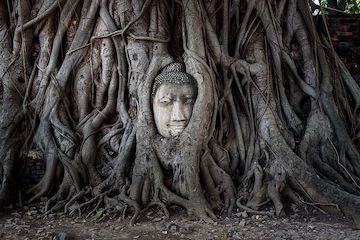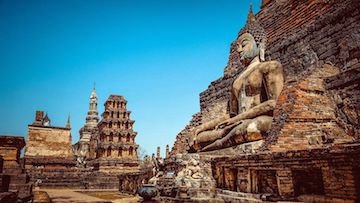Introduction to the history of Buddhist Councils and Schools
 Four Buddhist Councils
Four Buddhist Councils
Part 1
Introduction
The Buddhist schools that arose after the Buddha’s final Nirvana, are a complex but quite well-studied topic among Buddhist scholars. These studies range from the early 19th century to what we know today. The main problem with the sectarian treatment of Buddhist schools can be formulated as being too one-sided affairs, where it solely relies on a particular text or range of texts from only one school. Each school’s treatment of the ‘other schools’ tenets logically shows some form of bias, as to how they deal with doctrinal points that are controversial to them. In some cases, as will be shown in this series, the treatment of the teachings of other schools borderlines on misrepresentation, in order to refute them with their own doctrine. Every school claimed, in their view and exposition of their tenets, that they held the true version of the teachings and finer points of explanations in their Abhidharma texts and commentaries (sastras).
Buddha's Death
Besides all these ‘controversies’ and disagreements between the early schools, it is not pointed out often enough, that most early Buddhist schools agreed with each other for the most part. All schools agreed on the core teachings of the Buddha, i.e., the 37 aids to Enlightenment (Pali: bodhipakkhiya dhamma, Sanskrit: bodhipaksiya dharma).
Bodhipaksiya Dharma
An important note on the differentiation between the usage of the older term Sthavira(vada) and the more commonly known newer term Theravada: in early Buddhist schools, that were not considered orthodox in the sense of how Theravada considers themselves today, it was common for the elders in a school to be called Sthaviras. These were the older, senior monks, who were identified and considered the most learned in that particular school.
The Elders
Both the word Sthavira and Thera means elder, but for example, during the time of the compilation of the Sarvastivada Mahavibhasa (the great commentary), around the 1st century A.D., the four Sarvastivada masters were referred to as great Sthaviras. This note is particularly important when reading the accounts of the Chinese pilgrims who visited India, where they mention the term Sthavira, and it is not clear which school is being mentioned in a particular location, region, or monastery that they visited.
Sarvastivada Mahavibhasa
I am using the word school as a designation for the different sects of early Buddhism, but this has a varying level of interpretation throughout the history of Buddhism. The schools did not start out as full-fledged with their own monasteries and universities all over India. Instead, what started as a group of wandering monks during the time of the Buddha, and became more grouped in early settlements (avasas and aramas) in various locations a century later, eventually became monasteries (lenas), and eventually full-fledged viharas centuries later.

Texts
Buddhism started out as an oral tradition, and the transmission of the teachings of the Buddha were done through recitation of the memorized texts. Only centuries later, were these texts committed to a written form. Various texts from different schools of Buddhism have survived the test of time, that discuss the history of the Buddhist schools, as well as how each school dealt with the doctrinal points of other schools with whom they disagreed.
The Theravada texts are written in Pali, a prakrit vernacular:
Pali Text Society
Vinaya pitaka — Cullavaga
Dipavamsa
Mahavamsa
Katha-vatthu
The Sarvastivada texts were written in a hybrid form of Sanskrit, also known as Buddhist Sanskrit. Some of them only survived in their Chinese and/or Tibetan translations:
Buddhist Sanskrit
Hsuan-chwang’s I-pu’-tsung-lun-lun, being a Chinese translation of Vasumitra’s Samaya-bhedoparacanacakra
Vasubandhu’s Abhidharmakosabhasyam
Bhavya’s nikaya-bheda-vibhanga-vyakhyana
Vinitadeva’s nikaya-bhedo-padarsana-samgraha
The Sammitiya texts were also written in Buddhist Sanskrit, but some of them only survived in their Chinese and/or Tibetan translations:
Buddhist Sanskrit
Sammitiya-nikaya-sastra
Tridharmaka-sastra
Vinaya-dvavimsatividya-sastra
An overview
I’ll be covering the most interesting phases of the development of early Buddhism from multiple angles — in relation to Buddhist councils, geologically in Northern and Southern analysis, through the eyes of Chinese pilgrim monks who visited India in the 4th to 7th centuries, and how schools dealt with the doctrines of other schools.
Here’s a nice overview of what we’ll be covering in this series that you can look forward to:
2. Buddhist Councils — Who, when, where, and why?
3. General history of Buddhist schools according to the ‘Northern’ Buddhists of Sarvastivada
4. General history of Buddhist schools according to the ‘Southern’ Buddhists of Theravada
5. Buddhist schools at the time of the First ‘Maha-Kasyapa’ Council at Rajagaha
6. Buddhist schools at the time of the Second Council at Vaisali (and the subsequent Mahasanghikas Council)
7. Buddhist schools at the time of the Third ‘Moggaliputta Tissa’ ‘Asoka’ Council
8. Buddhist schools at the time of the Fourth ‘Vasumitra’ ‘Kanishka’ Council at Jalandhar
9. Buddhist schools in the 5th Century A.D. according to the Chinese pilgrim Fa-hsien
10. Buddhist schools in the 7th Century A.D. according to the Chinese pilgrim Yuan-Chuang
11. How the Theravada school dealt with doctrinal points from other schools — The Katha-vattu
12. How the Sarvastivada school dealt with doctrinal points from other Schools — Vasumitra and Vasubandhu
13. How the Sammitiya school dealt with doctrinal points from other Schools — The Sammitiya Nikaya Sastra
14. The Pudgalavadins, the sub-schools, and what they taught according to their own surviving texts — The primary theses
15. The Pudgalavadins, the sub-schools, and what they taught according to their own surviving texts — The secondary theses
16. The Buddhist Councils according to the 7th Century A.D. Chinese pilgrim Yuan-Chuang
17. Conclusion
In the next article in this series, we’ll cover the Buddhist councils that were held, who was involved in these councils, when and at what location, and the possible reasons why these councils were needed in history.

Research References
Aung, S.Z. and Rhys Davids, C.A.F. — Points of Controversy or Subjects of Discourse, Being a Translation of the Katha-vatthu from the Abhidhamma-Pitaka, 1915, Pali Text Society.
Baruah, Bibhuti — Buddhist Sects and Sectarianism, 2000, Sarup & Sons.
Bhikkhu KL Dhammajoti — Abhidharma Doctrines and Controversies on Perception, third edition, 2007, Centre of Buddhist Studies, The University of Hong Kong.
Bhikshu Thich Thien Chau and Boin-Webb, Sara — The Literature of the Personalists of Early Buddhism, 1996, Motilal Banarsidass Publishers.
Conze, Edward — Buddhist Thought in India, Three Phases of Buddhist Philosophy, 1983, George Allen & Unwin.
Cox, Collett — Disputed Dharmas, Early Buddhist Theories on Existence, 1995, Tokyo, The International Institute for Buddhist Studies.
Dube, S. N. — Cross Currents in Early Buddhism, 1980, Manohar Publications.
Dutt, Nalinaksha — Buddhist Sects in India, second edition, 1978, Motilal Banarsidass Publishers.
Dutt, Nalinaksha — Development of Buddhism in Uttar Pradesh, 1956, Publication Bureau, Government of Uttar Pradesh, Lucknow.
Dutt, Nalinaksha — Early History of the Spread of Buddhism and the Buddhist Schools, 1930, Rajesh Publications.
Dutt, Nalinaksha — Early Monastic Buddhism, Volume 1, 1941, Calcutta Oriental Press Ltd.
Dutt, Nalinaksha — Early Monastic Buddhism, Volume 2, 1945, Calcutta Oriental Press Ltd.
Dutt, Nalinaksha — Gilgit Manuscripts, Volume 1, 1939, Calcutta Oriental Press Ltd.
Dutt, Nalinaksha — The Buddhist Sects, A Survey, 1945, B.C. Law, Volume 1, Indian Research Institute.
Geiger, Wilhelm — The Mahavamsa, or The Great Chronicle of Ceylon, 1912, Pali Text Society.
Hazra, Kanai Lal — Buddhism in India as Described by the Chinese Pilgrims AD 399-689, 1983, Munshiram Manoharlal Publishers Pvt. Ltd.
Hirakawa, Akira — A History of Indian Buddhism, From Sakyamuni to Early Mahayana, 1990, University of Hawai’i Press.
Horner, I. B. — Vinaya pitaka, The Book of the Discipline, Volume 5, Khandhaka - Cullavagga, 2001, Pali Text Society.
Lama Chimpa — Taranatha's History of Buddhism in India, 1970, Motilal Banarsidass Publishers.
Law, B.C. — The Debates Commentary (kathavatthuppakarana-atthakatha), 1940, Oxford University Press.
Malalasekera, G. P. — Dictionary of Pali Proper Names, Volume 2, 1938, John Murray, Albemarle Street.
Masuda, Jiryo — Origin and Doctrines of Early Indian Buddhist Schools, A Translation of the Hsuan-Chwang version of Vasumitra’s Treatise, 1925, Asia Major, Volume 2.
Mizuno, Kogen — Buddhist Sutras, Origin Development Transmission, 1987, Kosei Publishing.
Obermiller, E. — History of Buddhism by Bu-ston Part 1, The Jewelry of Scripture, 1931, O. Harrassowitz, Leipzig.
Oldenberg, H. — The Dipavamsa, An Ancient Buddhist Historical Record, 1879, Williams and Norgate.
Pande, Govind Chandra — Studies in the Origins of Buddhism, fourth edition, 1995, Motilal Banarsidass Publishers.
Potter, Karl H. — Encyclopedia of Indian Philosophies, Volume 7, Abhidharma Buddhism to 150 A.D., 1996, Motilal Banarsidass Publishers.
Priestley, Leonard — Pudgalavada Buddhism, The Reality of the Indeterminate Self, 1999, University of Toronto, Centre for South Asian Studies.
Pruden, Leo M. — Abhidharmakosabhasyam of Vasubandhu, Volume 4, 1991, Asian Humanities Press.
Rhys Davids, T. W. — The Sects of the Buddhists, 1891, The Journal of the Royal Asiatic Society.
Venkataramanan, K. — Sammitiya Nikaya Sastra, 1953, Visva-bharati Annals, Volume 5.
Watters, Thomas — On Yuan Chwuang’s Travels in India 629-645 A.D. Volume 1, 1904, Royal Asiatic Society.
Watters, Thomas — On Yuan Chwuang’s Travels in India 629-645 A.D. Volume 2, 1905, Royal Asiatic Society.
Williams, Paul — Buddhism Critical Concepts in Religious Studies, Volume 1, Buddhist Origins and the Early History of Buddhism in South and Southeast Asia, 2005, Routledge.
Williams, Paul — Buddhism Critical Concepts in Religious Studies, Volume 2, The Early Buddhist Schools and Doctrinal History; and Theravada Doctrine, 2005, Routledge.
Williams, Paul — Buddhism Critical Concepts in Religious Studies, Volume 3, The Origins and Nature of Mahayana Buddhism; Some Mahayana Religious Topics, 2005, Routledge.
Pictures Are From Pixabay


 A link to My Blog
A link to My Blog




 A link to My Blog
A link to My Blog
@reddust, You introduced nicely using fully contents about the history of Buddhist Councils and Schools. I've already learned lot of books there in my school life and then after passed life. I accept happened disagreements between the early schools about Buddha's death. But I accept how introduced lot of our Buddhism books.
Yep I accept with your above contexts. For Sri Lanka, main religion is Buddhism. So every schools teach Buddhism language. Sunday Dhamma school's teach Theravada & Pali languages.
Dear @madushanka, thank you....Most of the disagreements were minor. What we call the Theravada school disagreed with what is now Mahayana like schools regarding the vinaya rules. Theravada were very strict and didn't want lay people, bodhisattvas involved in the councils. This is all about opinions and human behavior, I guess even if you are enlightened you are going to have issues with people who don't agree with your view...hahaha
I have learned a little Pali and Sanskrit researching topics and words to see if the translations I have matched other translator's works.
This is a promising start to an interesting series, I don't know much about Buddhism
Interesting points in particular include that the initial 4 schools mostly agreed with each other and that the traditions were mostly oral; over years and decades, oral traditions would very likely end up with at least local divergences in the schools
The evolution and migration of Buddhism and other religions have always been interesting to me. The silk road spread different kinds of religion throughout the known world. Religions were traded just like other marketable goods. ;-)
It is interesting to see that even within Buddhist schools there is some sort of bias and rivalry between them. This probably describes more the human nature of the people within those schools. I would like to know if there is some sort of consensus or the differences are left as " differences in opinion". The good thing is that the differences do not seem to be deadly as in Christianity or Islam.
@macusantoniu, the Dalai Lama is reaching out to other Buddhist tradition and asking them all to engage in the world's problems ogether using what Buddha taught to bring peace and harmony.
Harmony among the Different Buddhist Traditions
Now, as I mentioned yesterday when we met the leaders from Burma and Laos and some others, in the past, because of the names so-called “Hinayana,” “Mahayana” and “Tantrayana,” people got the impression these three yanas [vehicles] are something really different and separate. That’s totally mistaken. As I mentioned briefly this morning, the Theravada tradition, or Pali tradition, is the foundation of Buddhadharma; and the practice of vinaya [monastic vows and discipline] is the foundation of Buddhadharma.
https://www.dalailama.com/messages/buddhism/buddhist-congregation-2011-address
So regardless of the differences everything is about peace and harmony, correct? That leads me to the next question: What do Buddhists think of Christianity and Islam?
@reddust,
I saw a comment which discuss this much deeper! Better you visit SL and sometimes you might not known, SL is the place which written Tripitaka! Better you come here! Yeah Theravada is little strict in Vinaya (Rules)! I am personally believe Vinaya (Rule or Control)is the key of Buddhism! Specially the control of mind is the key of path to Nirwana! Great article my dear friend! I appreciate your effort to find those details!
Cheers~
It is interesting that people in different parts of India had different interpretations of what Buddha preached.
Buddhist schools have an ancient history
A very special article and a really unique explanation
Well done, my friend
the presentation is very complete, I am not a Buddhist, but it is not wrong to know the budha religion elements for the knowledge of history and the term in budha.
India is majority Buddhist and until now they still dominate Buddhism.
in my teaching to teach harmony in religion, we do not want to disturb and force the belief of people around.
humans have the right to choose their respective beliefs.
"living in peace" will be beautiful even though surrounded by different religions. Thanks @reddust
Buddhism has been a huge part of bengali culture.There are some place in Bangladesh where lord Buddha visited.
The Ancient Buddhist Universities in Bangladesh:
Somapura Mahavihara in Naogaon, Rajshahi Division.
Jagaddala Mahavihara in Naogaon, Rajshahi.
Halud Vihara in Naogaon, Rajshahi.
Agrapuri Vihara in Naogaon, Rajshahi.
Vasu Vihara in Bogra, Rajshahi.
Sitakot Vihara in Nawabganj, Rangpur Division.
Excellent post.muy intructivo and interesting history
nice knowledge boss @reddust.